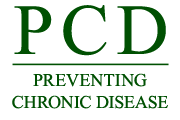PCD News Summary for June 8, 2017

Notice to News Media – PCD Release Time and Embargo Policy:
CDC’s News Media Branch releases to reporters the PCD media packet every Tuesday afternoon between 12 and 2 pm.
Embargoed until Thursday, June 8, at 12:00 PM ET
Comparing Prevalence Estimates From Population-Based Surveys to Inform Surveillance Using Electronic Health Records
The two one-sided t test (TOST), commonly used by the pharmaceutical industry to test whether one drug works as well as another, also has important applications in epidemiology. Electronic health record (EHR) systems provide a new opportunity to use health care data for population health surveillance. Population health estimates from EHR data are most commonly validated against estimates from surveys using statistical tests of whether estimates are different (such as the t-test), but these tests can produce meaningless results when sample sizes are large. We explored a novel application of a method to assess equivalence, the TOST, to determine whether estimates from two population-based surveys were statistically equivalent. This work will guide the use of equivalence testing for validating EHR-based population health estimates.
Melissa Newton
mnewton@cdc.gov
404-718-6281
Factors Associated With Parents’ Intent to Vaccinate Adolescents for Human Papillomavirus: Findings From the 2014 National Immunization Survey–Teen
Among parents of US adolescents ages 13 to 17 years, maternal education emerged as the strongest predictor of parental intent to obtain human papillomavirus vaccination for their children. Researchers analyzed data on 10,354 adolescents ages 13 to 17 years from the 2014 National Immunization Survey–Teen. Among unvaccinated adolescents, mothers with less than a high school diploma, Hispanic ethnicity, and having a health care provider recommend the vaccine were significantly associated with parents’ intention to have their adolescent child vaccinated within the next 12 months. In addition, non-Hispanic black race was a significant predictor of parents’ intent to vaccinate for boys.
Melissa Newton
mnewton@cdc.gov
404-718-6281
###
Note: Not all articles published in PCD represent work done at CDC. In your stories, please clarify whether a study was conducted by CDC (“a CDC study”) or by another institution (“a study published by CDC”). The opinions expressed by authors contributing to PCD do not necessarily reflect the opinions of CDC or the institutions with which the authors are affiliated. PCD requests that, when possible, you include a live link to the article in your stories.
###
U.S. DEPARTMENT OF HEALTH AND HUMAN SERVICES
CDC works 24/7 protecting America’s health, safety and security. Whether diseases start at home or abroad, are curable or preventable, chronic or acute, stem from human error or deliberate attack, CDC is committed to respond to America’s most pressing health challenges.
- Page last reviewed: June 8, 2017
- Page last updated: June 8, 2017
- Content source:



 ShareCompartir
ShareCompartir